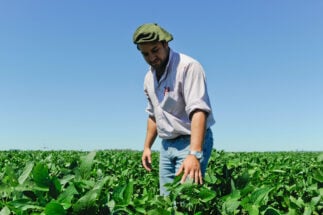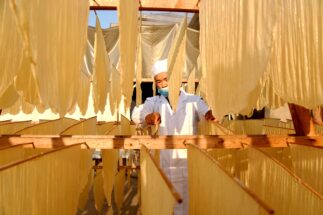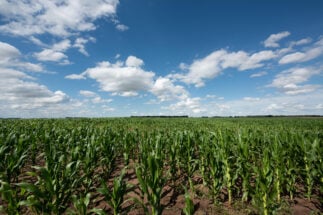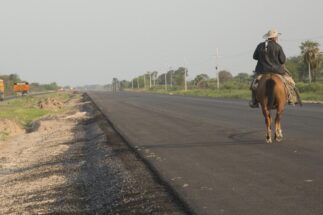The growing global demand for conventional, non-genetically modified (GM) soybeans has not changed agricultural trends in Latin America, where producers continue to maintain a preference for GM varieties.
Unlike genetically modified alternatives, conventional soybeans require more complex handling, something which is compensated for by its higher selling price. But they have not yet proven competitive on the mass market, with their adoption currently limited to a small section of producers, passionate about their use and promotion.
The difficulties in the management of conventional soybeans are linked to the use of agrochemicals – a task which, unlike with GM variants, must be carried out according to a very strict calendar of dates and times. Both alternatives involve the use of pesticides, with their total elimination only occurring in the production of so-called “organic” soybeans.
Producers’ choice
Although there are no consolidated statistics at the regional level, Diálogo Chino’s analysis found that in Argentina, Brazil and Uruguay – which together account for almost half of the world’s soybean production – GM variants represent nearly 98% of the soybean area sown. This percentage is even higher than a decade ago, when it stood at 88%, according to a study by the Inter-American Institute for Cooperation on Agriculture (IICA).
98%
of the area sown with soybean in Argentina, Brazil and Uruguay is planted with genetically modified variants
“For conventional soybean production to be profitable, a high degree of efficiency is required, as crop management must be much more specific, be very alert to the timing of weed control and make more applications of agrochemicals,” said Pedro Rocha, one of the authors of the report.
“Added to this is the need for a traceability process, to avoid the accidental presence of GM soybeans, which also increases costs,” Rocha added.
Alongside these complexities, there is now a growing demand for non-GM soybeans, driven by changes in global consumer trends, as well as changes in food policies in Europe and Asia. According to Market Data Forecast, the market is projected to grow from the current US$23.2 billion to around US$38.2 billion by 2027.
For now, this trend is not altering producers’ preferences. According to Argentine government data, during the 2020-21 season, more than 97% of the area planted with soybeans is sown with GM varieties. Meanwhile in Brazil, the Instituto Soja Livre, an association that brings together producers, traders and seed companies, recently reported that non-GM soybeans account for 2% of the area planted. In Uruguay, sources from the Ministry of Agriculture explained that during the last season, non-GM soybeans accounted for less than 1% of total production.
A difficult path – for now
“Conventional soya is aimed at niche markets, unlike transgenic soya, which is governed by quantity and volume,” explained Julio Ferrarotti, head of Haziak, an Argentine company that has been committed to traditional varieties since 2016. They are currently planting on 200 hectares in Argentina, and are in the process of seeking permits to do the same in Uruguay. He explained that the company began by aiming for “genetic improvement”, before partnering with producers.

Ferrarotti said that the differential in price for conventional soybeans varies depending on the client. “It is discussed on a contract by contract basis,” he said, stressing that Haziak’s model is not particularly simple due to the high costs involved – a point echoed by Sergio Ceretta, who oversees the soybean breeding programme at the National Agricultural Research Institute (INIA) in Uruguay: “Although you get a price differential, you have more costs because you have to guarantee a chain where the grain is free of contamination.”
Price was also mentioned as a barrier by Dante Servian, a producer from the Itapúa area of Paraguay. “The premium is sometimes less than 10% of what GM soya is. If it were 25% or 30%, it would have more development,” he told Diálogo Chino. In 2018, Servian and a group of businessmen undertook the construction of a stockpiling facility for non-GM products, but he explained that they have not been able to move forward, “because the government has not made progress with seed certification, a requirement demanded by buyers.”
As Servian reports, official support for non-GM soybeans has so far been scant. Diálogo Chino contacted the Brazilian Ministry of Agriculture, seeking more information on incentives for producers to adopt conventional varieties, to which came the official response of “it is not up to the government to interfere in market issues”. Leonardo Olivera, director of agricultural services at the Uruguayan Ministry of Agriculture, returned a similar statement, warning that “we as a government do not have a preference for any crop”. Meanwhile, in Argentina, the executive branch of government has so far not expressed any official policy or position on the matter.
The market is currently at prices that are surely not attractive enough to get into a complicated business
This does not mean that programmes to promote conventional soybeans do not exist. Sergio Ceretta explained that INIA has a study underway to evaluate the market for this variety in Asia, seeking to improve profitability for Uruguayan producers.
In Argentina, the National Agricultural Technology Institute (INTA), an autonomous research body, has supported several projects related to the issue. One of the most successful led to the official patenting in July of La Manuela, a non-GM soybean with high protein value. “I started this in 2007. I can now say that I have left my mark in this world,” said Francisco Ferramondo, the farmer in charge of its development, who went on to say that “conventional soya has a tremendous future”.
Why is there not a greater adoption of these variants, we asked Ferramondo. “In our case, we don’t have the means to get publicity, and at the same time the GM lobby is very big,” he said, adding that “producers look at the numbers, and everyone says that it is more comfortable to opt for GM.” Ceretta agreed, indicating that currently, “the market is at prices that are surely not attractive enough to get into a complicated business.”
The use of agrochemicals
Whenever issues linked to GM crops are mentioned, there is always debate over their environmental impact. For Ferramondo, developer of La Manuela, the contribution of such non-GM varieties is, comparatively, a “pampering for the environment”. But Pedro Rocha of IICA said “there is no experimental evidence to support the negative aspects of GM soya.”

As Diálogo Chino explored previously, the GM debate is by no means closed, primarily because there is not yet a sufficient volume of research to generate a categorical conclusion.
Controversy aside, there is one thing that all interviewees made clear: using non-GM soybeans does not mean that agrochemicals can be left aside. In fact, several pointed out that, given their complex management in the field, this variant could in fact mean a greater use of agrochemicals. Paraguayan producer Dante Servian was keen to stress that organic soybeans are the only form that do not make use of pesticides.
Organic soybeans were a main focus at the last Mercosoja Congress, held in Brazil this May. Discussions at the meeting reported that the Chicago Mercantile Exchange – the world’s largest options and futures market – is analysing the possibility of having a reference price for this product, which could further expand its adoption, already driven by the growing global demand for this type of food.








